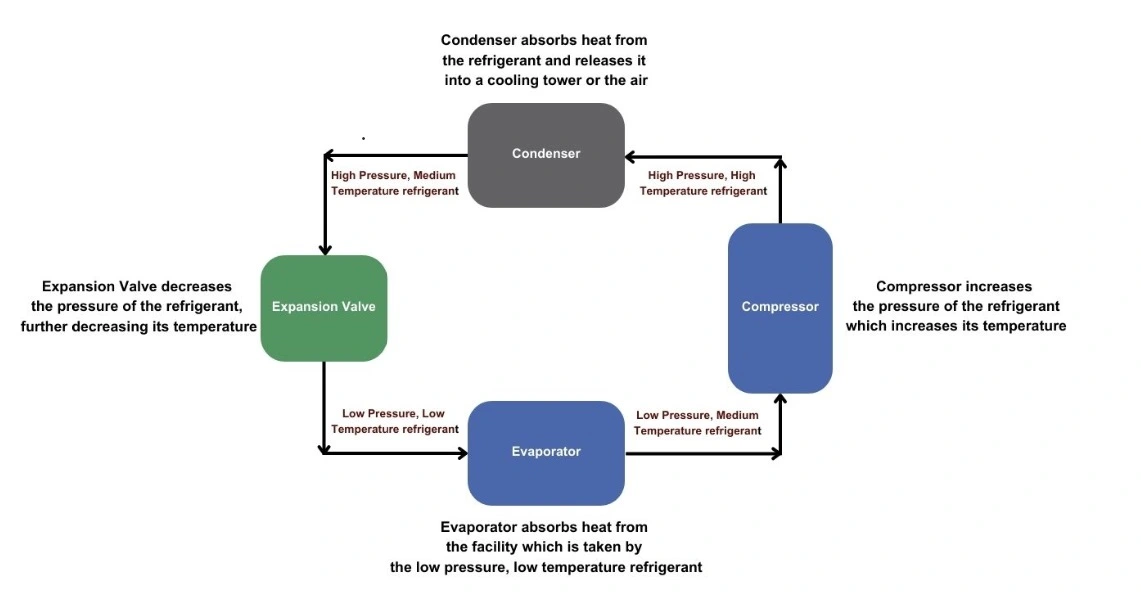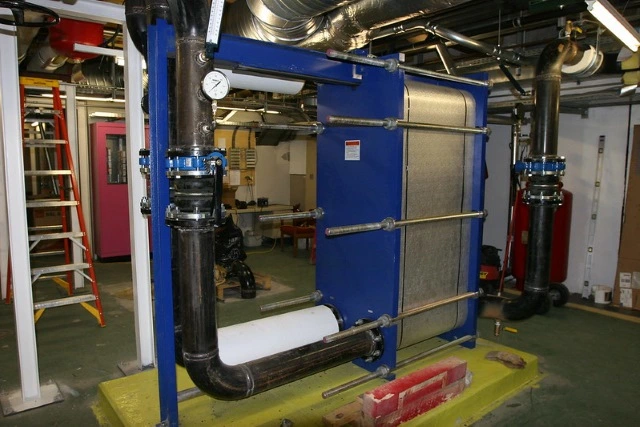The right cooling system, proper installation, and regular maintenance can make a massive impact on a commercial real estate (CRE) building’s efficiency and comfortability. Chiller systems typically offer the most efficient and consistent method of cooling indoor spaces. However, to operate efficiently, chiller systems need to be designed and optimized around the specifics of the building it cools.
What is a chiller system in a commercial building?
A chiller system uses a vapor-compression or absorption refrigeration cycle to remove heat from a liquid. This liquid can then be circulated through a heat exchanger to cool air or equipment as required. In commercial buildings, chiller systems act as the source of cold air pushed by HVAC (heating, ventilation, and air conditioning) systems. They can also help maintain humidity levels to create a comfortable environment for occupants.
Commercial chillers and their benefits
Commercial chillers are the most commonly used method of removing heat from a facility. A few key benefits that contribute to their popularity include:
- Efficiency: Using a vapor-compression or absorption refrigeration cycle, chillers can reduce energy consumption compared to traditional air conditioning units that cool the air directly. Chillers can run as efficiently as 0.325 kW per ton of cooling capacity.
- Long lifespan: Commercial chillers are designed for longevity. With proper maintenance, water-cooled chillers have a functional lifespan of 20-25 years, while air-cooled chillers have an operational lifespan of 15-20 years.
- Reliability: Chillers, both water-cooled and air-cooled types, are known for their reliability. Water-cooled chillers are typically housed indoors, which shields them from the wear and tear caused by outdoor elements. This indoor placement makes their maintenance needs more predictable and reduces the risk of sudden breakdowns due to weather-related issues. Air-cooled chillers still offer reliability because they are relatively simple to maintain with clear signs of maintenance needs.
- Versatility: Aside from cooling spaces, chillers can also cool equipment. For example, in data centers, chillers keep servers cool to prevent them from overheating and ensure a smooth operation. Offering these capabilities to tenants can help open your commercial spaces up to new audiences.
How they work and diagrams
Using the ideal gas law and thermodynamic principles, chillers provide cooling by removing heat. The key to this process is how gases increase in temperature as their pressure increases.

This thermodynamic principle means that chillers can increase the temperature of a refrigerant to expel heat by increasing its pressure with a compressor. Water-cooled chillers increase the efficiency of this process by using a cooling tower that extracts heat from the refrigerant with water. On the other hand, air-cooled chillers simply expel heat into the environment.
Then, the chiller system lowers the temperature of the refrigerant by reducing the pressure with an expansion valve. Due to the second law of thermodynamics, the high-temp, high-pressure refrigerant expels heat, and the low-temp, low-pressure refrigerant absorbs heat.
Three major chiller types used in CRE
In the commercial real estate sector, three main types of chillers are used:
- Air-cooled chillers: These chillers use air to remove heat from the refrigerant in the condenser. They are typically easier to install and require less maintenance than other types, but they may be less energy-efficient in warmer climates.
- Water-cooled chillers: Although more energy-efficient than air-cooled chillers, they require indoor space and a constant water source. Instead of extracting heat from the refrigerant directly into the air, water accomplishes this within a cooling tower, making the heat removal process more efficient.
- Evaporative chillers: Also known as absorption chillers, they use a heat source to create pressure in the refrigerant, typically in combination with a cooling tower. While they can be more complex and expensive to install, they can be a highly efficient cooling solution, particularly in hot, dry climates.
Different types of cooling systems
Beyond chiller plants, other standard cooling systems used in commercial real estate include:
- District cooling systems: These large-scale systems provide cooling for multiple buildings or an entire district from a central plant using chilled water or other mediums.
- Variable refrigerant flow (VRF) systems: VRF systems use refrigerant as the cooling medium and allow for individual control of the cooling in different zones within a building.
- Ductless mini-split systems: Without needing ductwork, these systems are a good solution for older buildings or additions where installing ductwork is not feasible.
The best solution and best practice to provide cooling energy
As a best practice, it’s highly recommended to conduct a thorough analysis of the building’s cooling needs and the total cost of ownership of the cooling system over its lifetime, including installation, energy costs, and maintenance. This analysis can help determine the ideal cooling system for your commercial buildings.
When choosing a cooling system, energy efficiency is a key consideration. HVAC systems typically account for roughly 47% of a commercial building’s energy use in the United States.
Water-cooled chillers are often the most efficient commercial option due to their superior energy performance. Evaporative chillers also enhance efficiency through continuous water recirculation over condenser tubes, improving heat transfer. However, they may require additional maintenance.
Air-cooled chillers present an excellent alternative when space is limited or water availability is constrained. By using air to remove heat, these systems are practical where water is restricted or expensive. Each chiller type has its own strengths, suiting different situations.
Optimizing your chiller systems for best performance
With over 120,000 commercial chillers in the United States wasting 30% of their energy, building optimization requires focusing on commercial chillers. Integrating smart technology and proactive maintenance strategies is essential to the efficiency of a chiller system.
Understanding the importance of IoT and BMS integration
Integrating Internet of Things (IoT) sensors and Building Management Systems (BMS) is pivotal in enhancing the operation and efficiency of chiller systems.
IoT enables the collection of real-time data from chillers, offering a detailed insight into their operation far beyond what can be gained by a visual inspection. The BMS can utilize this granular data to monitor actual operating conditions, detect potential issues, and optimize system performance. Connecting the data to your BMS also enables the immediate notification of the appropriate parties for any problems.
“Effective energy management hinges on the seamless synergy of the Building Management Systems with HVAC components, including chillers. Each precise adjustment translates to optimized HVAC performance and sustainability.” – Dr. Erik Wallin, Chief Ecosystem Officer at ProptechOS.
Increasing the efficiency
Enhancing your chiller system’s efficiency can lead to substantial cost savings. A few opportunities to increase the efficiency of most commercial chillers include:
- Regular maintenance: Ensures the system remains in good working order, preventing energy losses due to wear and tear, such as scaling in the pipes.
- System upgrades: Advanced components and systems can offer more efficiency than their outdated counterparts. Regularly assessing potential upgrades keeps your system up-to-date.
- BMS integration: A Building Management System can monitor energy consumption and pinpoint areas for improvement, helping to keep the system running at peak efficiency.
- Holistic focus: Improving the efficiency of one component can impact the efficiency of other features in a chiller system, so it’s essential to take a holistic view when making upgrades or changes.
The rise of Proptech for building owners and what the future holds
Property technology, or Proptech, has significantly changed the CRE industry, with particular benefits for optimizing chiller systems. Proptech solutions can leverage the granular data from IoT devices to monitor and control chiller systems remotely, predict maintenance issues before they occur, and optimize energy use.
As we look to the future, integrating Proptech into a unified environment becomes essential. Platforms like ProptechOS can consolidate various high-tech property solutions, providing a holistic view of building operations and paving the way to leverage future technological advancements. You can try ProptechOS for free today to see how unifying your Proptech and building data can improve the operational efficiency of your commercial buildings.

Dr. Erik Wallin
Chief Ecosystem Officer, and founder of ProptechOS and RealEstateCore is recognized as a leader in Building Operating Systems (BOS) and making the buildings of the world smarter. He holds an MSc and a Ph.D. in Media and Computer Science from KTH Royal Institute of Technology.
Read his full bio and information here.

